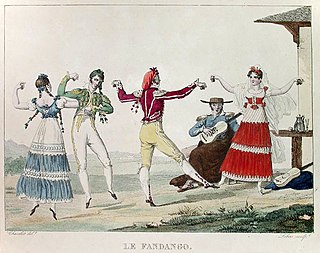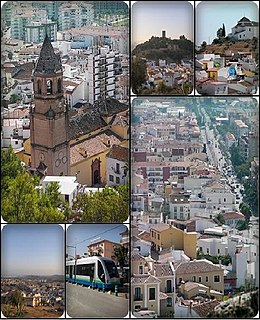Verdiales are a Flamenco music style, and song form belonging to cante chico.
Originating in Almogía, near the Spanish port of Málaga in Andalucía, it is based upon the fandango. For this reason, the verdiales are sometimes known as fandangos de Málaga.
Normally played in the key of E phrygian (key of C major with a sharpened fifth) and rarely in A minor, the verdiales have a 12-count rhythm similar to the soleares, and bulerías.
Listen to verdiales(2:18, 502Kb). This example shows some of the more common falsetas you are likely to hear at an informal flamenco performance.

Flamenco, in its strictest sense, is an art form based on the various folkloric music traditions of southern Spain, developed within the gitano subculture of the region of Andalusia, but also having a historical presence in Extremadura and Murcia. In a wider sense, it is a portmanteau term used to refer to a variety of both contemporary and traditional musical styles typical of southern Spain. Flamenco is closely associated to the gitanos of the Romani ethnicity who have contributed significantly to its origination and professionalization. However, its style is uniquely Andalusian and flamenco artists have historically included Spaniards of both gitano and non-gitano heritage.
The Music of Andalusia encompasses a range of traditional and modern musical genres which originate in the territory of Andalusia in southern Spain. The most famous are copla and flamenco, the latter being sometimes used as a portmanteau term for various regional musical traditions within Andalusia. Today, Andalusia has a rich and thriving musical scene, which draws from its own musical traditions as well as from external influences such as salsa, jazz or pop music.

Fandango is a lively partner dance originating from Portugal and Spain, usually in triple meter, traditionally accompanied by guitars, castanets, or hand-clapping. Fandango can both be sung and danced. Sung fandango is usually bipartite: it has an instrumental introduction followed by "variaciones". Sung fandango usually follows the structure of "cante" that consist of four or five octosyllabic verses (coplas) or musical phrases (tercios). Occasionally, the first copla is repeated.

Vélez-Málaga is a municipality and the capital of the Axarquía comarca in the province of Málaga, in the Spanish autonomous community of Andalusia. It is the most important city in the comarca. Locally it is referred to as Vélez. Vélez-Málaga is the headquarters of the Commonwealth of Municipalities of Costa del Sol-Axarquía. The municipality forms part of the Costa del Sol region.
Rumba flamenca, also known as flamenco rumba or simply rumba, is a palo (style) of flamenco music developed in Andalusia, Spain. It is known as one of the cantes de ida y vuelta, music which diverged in the new world, then returned to Spain in a new form. The genre originated in the 19th century in Andalusia, southern Spain, where Cuban music first reached the country.

Iberia is a suite for piano composed between 1905 and 1909 by the Spanish composer Isaac Albéniz. It is composed of four books of three pieces each; a complete performance lasts about 90 minutes.
Malagueñas is one of the traditional styles of Andalusian music (flamenco), derived from earlier types of fandango from the area of Málaga, classified among the Cantes de Levante. Originally a folk-song type, it became a flamenco style in the 19th century. It is not normally used for dance, as it is generally interpreted with no regular rhythmic pattern, as a "cante libre". It has a very rich melody with virtuous flourishes and use of microtones. Its guitar accompaniment is normally played in open position first inversion giving E for the tonic, which can be transposed by using a capo.

A palo or cante is the name given in flamenco for the different traditional musical forms.
Cartageneras are a flamenco palo belonging to the category of the cantes de las minas or cantes minero-levantinos. As the rest of the songs in this category, it derives from older folkloric fandango styles. The origin of this particular style is attributed to traditional fandango from the miner area of Cartagena in the province of Murcia, in southern Spain.
Cantes libres is a Spanish expression that literally means "free songs". It is applied on any flamenco palos in which there is no recognisable metre (music) or rhythmic pattern. The melody thus flows freely, unconstructed by metre, so singers can shorten or lengthen musical phrases at will, as long as they respect the basic melodic line of the style they are singing.
José Tejada Marín, known as Pepe Marchena and also as Niño de Marchena in the first years of his career, was a Spanish flamenco singer who achieved great success in the ópera flamenca period (1922–1956). Influenced by singers like Antonio Chacón, he carried to the extreme the tendency to a more mellow and ornamented style of flamenco singing. Owing to his particular vocal conditions and singing style, he excelled mainly in palos (styles) like fandangos, cantes de ida y vuelta and cantes libres, contributing to making them the most popular flamenco styles in the era of the ópera flamenca, and created a new cante de ida y vuelta, the colombiana, later recorded by many other artists like El Lebrijano or Enrique Morente. He was also the first flamenco singer to use an orchestra to accompany flamenco singing, though later he returned to the guitar.
The cante flamenco, meaning "flamenco singing", is one of the three main components of flamenco, along with toque and baile (dance). Because the dancer is front and center in a flamenco performance, foreigners often assume the dance is the most important aspect of the art form — in fact, it is the cante which is the heart and soul of the genre. A cante singer is a cantaor or cantaora.
This is a glossary of terms that relate to flamenco arts.

Cártama is a town and municipality in the province of Málaga, part of the autonomous community of Andalusia, southern Spain. The municipality is situated approximately 17 km (11 mi) from Málaga. It is one of the most extensive towns in the province, covering c. 150 km2 (58 sq mi). Cártama has a population of approximately 15,000 residents.

Valle de Abdalajís is a town and municipality in the province of Málaga, part of the autonomous community of Andalucía in southern Spain. It is located in the comarca of Antequera. The municipality is situated approximately 50 kilometres from the provincial capital of Málaga. It has a population of approximately 3,000 residents. The natives are called Vallesteros.
A Rondeña is a palo or musical form of flamenco originating in the town of Ronda in the province of Málaga in Spain.

The Feria de Agosto or Feria de Málaga takes place every August in the city of Málaga, Andalusia, Spain.

Chambao were a flamenco-electronic band originally from Málaga, Spain, known for a Flamenco Chill sound that fuses flamenco sounds and palos with electronic music. The name of the band is taken from an improvised form of beach tent that is constructed as a means of sheltering from the wind and sun.
Cancanilla de Marbella is the artistic name of the gypsy singer and dancer Sebastián Heredia Santiago, born in Marbella, Spain, in 1951, and resident in Madrid.
Gracia Cabrera Gómez, known professionally as Gracia Montes, was a Spanish copla singer.









